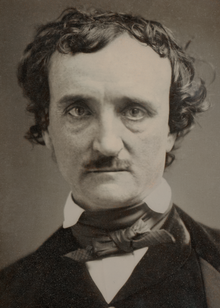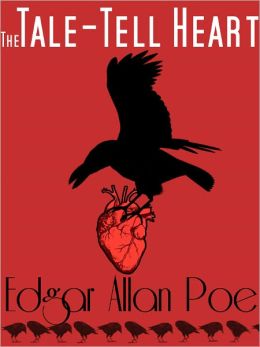
Poe was born in Boston. He was a poet, writer editor and literary critic. His short stories were his main type of writing, and today they are considered some of the best American short stories in history. His tales usually are a mix of mystery and macabre (grim and dealing with death).
Poe married his 13-year old cousin, Virginia Clemm. Her early death may have inspired some of his writing. Poe's best known fiction are Gothic (horror and romance) in order to appeal to the public's tastes at the time.
In terms of literary theory, Poe's criticisms and essays reflected his belief that a work's meaning should be an undercurrent "just below the surface". He thought that works with obvious meanings were no longer art.
The Tell-Tale Heart THE TELL-TALE HEART SUMMARY
This animated version of The Tell-Tale Heart was made in 1953 by UPA for Columbia Pictures. The voice is narrated by James Mason. But beware - this isn't a cutesy cartoon for kids. In fact, it's pretty scary. It was the first cartoon to be X-rated (adults only) in Great Britain under the British Board of Film Censors classification system. Totally awesome.
Literary Techniques
1. in media res
The story begins in media res - in the middle of an event. This is obvious because the story begins with a conversation that's already begun. The narrator is talking to someone else - another person who is not identified. It could be a prison warden, a judge, psychiatrist, etc.
2. Repetition
You'll notice that throughout the story, Poe repeats certain words. This helps emphasize the thought process of the narrator. He often says "very, very" when recounting events. The effect of repetition also indicates the "acuteness of his senses" - that is, his great sensitivity to everything going around him. This sensitivity, in turn, is what causes him to be so irritated by the old man's eye. Notice that it is not only just a repetition of certain words, but also a repetition in sentence structure, as seen below.
"TRUE!-nervous-very, very dreadfully nervous I had been and am…"
"I moved it slowly - very, very slowly, so that I might not disturb the old man's sleep.."
"I foamed - I raved - I swore!"
"They heard! - they suspected! - they knew!"
"And now - again! - hark! louder! louder! louder! louder!"
First-person narrative
The Tell-Tale Heart is written in first-person narrative. The narrator tells the story from his perspective to someone else. Notice how he refers to "you", the reader. He is trying to persuade you of his innocence and his sanity. (We're never actually told whether the narrator is a man or a woman. Most people assume that the narrator is a man.)
"You fancy me mad. Madmen know nothing. But you should have seen me. You should have seen how wisely I proceeded - with what caution - with what foresight, with what dissimulation, I went to work!"
3. Suspense
Right from the start of the story, Edgar Allan Poe uses imagery to describe the man's eye and to set up the ominous atmosphere of the story.
"All a dull blue with a hideous veil over it that chilled the very marrow in my bones…"
4. Trivia
If you've ever heard of the director Tim Burton, you should know that he was greatly influenced by Edgar Allan Poe's stories growing up. Burton has gone on to produce films such as the remake of Charlie and the Chocolate Factory, Edward Scissorhands, Batman Forever, The Nightmare Before Christmas and Beetlejuice.
Even The Simpsons uses The Tell-Tale Heart as a storyline in one of its episode. This episode, called "Lisa's Rival", involves Lisa's jealousy of one of her classmates. Her classmate creates a diorama of "The Tell-Tale Heart" and Lisa steals it. Lisa's guilt eventually ends in her confession of the theft, just like in Poe's story.



 留言列表
留言列表


